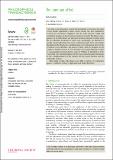Files in this item
The rarer-sex effect
Item metadata
| dc.contributor.author | Gardner, Andy | |
| dc.date.accessioned | 2022-10-11T09:30:13Z | |
| dc.date.available | 2022-10-11T09:30:13Z | |
| dc.date.issued | 2023-05-08 | |
| dc.identifier | 281665411 | |
| dc.identifier | dae1074f-791b-462a-ab01-84f15aeed1b4 | |
| dc.identifier | 85149217034 | |
| dc.identifier.citation | Gardner , A 2023 , ' The rarer-sex effect ' , Philosophical Transactions of the Royal Society B: Biological Sciences , vol. 378 , no. 1876 . https://doi.org/10.1098/rstb.2021.0500 | en |
| dc.identifier.issn | 0962-8436 | |
| dc.identifier.uri | https://hdl.handle.net/10023/26171 | |
| dc.description | Funding: This work was supported by a European Research Council Consolidator Grant (no. 771387) and a Natural Environment Research Council Independent Research Fellowship (no. NE/K009524/1). | en |
| dc.description.abstract | The study of sex allocation—that is, the investment of resources into male versus female reproductive effort—yields among the best quantitative evidence for Darwinian adaptation, and has long enjoyed a tight and productive interplay of theoretical and empirical research. The fitness consequences of an individual’s sex allocation decisions depend crucially upon the sex allocation behaviour of others and, accordingly, sex allocation is readily conceptualised in terms of an evolutionary game. Here, I investigate the historical development of understanding of a fundamental driver of the evolution of sex allocation—the rarer-sex effect—from its inception in the writing of Charles Darwin in 1871 through to its explicit framing in terms of consanguinity and reproductive value by William D. Hamilton in 1972. I show that step-wise development of theory proceeded through refinements in the conceptualization of the strategy set, the payoff function and the unbeatable strategy. | |
| dc.format.extent | 10 | |
| dc.format.extent | 670948 | |
| dc.language.iso | eng | |
| dc.relation.ispartof | Philosophical Transactions of the Royal Society B: Biological Sciences | en |
| dc.subject | Consanguinity | en |
| dc.subject | Game theory | en |
| dc.subject | Reproductive value | en |
| dc.subject | Sex allocation | en |
| dc.subject | Sex ratio | en |
| dc.subject | Unbeatable strategy | en |
| dc.subject | QH426 Genetics | en |
| dc.subject | QH301 Biology | en |
| dc.subject | MCC | en |
| dc.subject.lcc | QH426 | en |
| dc.subject.lcc | QH301 | en |
| dc.title | The rarer-sex effect | en |
| dc.type | Journal item | en |
| dc.contributor.sponsor | European Research Council | en |
| dc.contributor.sponsor | NERC | en |
| dc.contributor.institution | University of St Andrews. St Andrews Bioinformatics Unit | en |
| dc.contributor.institution | University of St Andrews. Institute of Behavioural and Neural Sciences | en |
| dc.contributor.institution | University of St Andrews. Centre for Biological Diversity | en |
| dc.contributor.institution | University of St Andrews. School of Biology | en |
| dc.identifier.doi | 10.1098/rstb.2021.0500 | |
| dc.description.status | Peer reviewed | en |
| dc.date.embargoedUntil | 2023-03-20 | |
| dc.identifier.grantnumber | 771387 | en |
| dc.identifier.grantnumber | NE/K009524/1 | en |
This item appears in the following Collection(s)
Items in the St Andrews Research Repository are protected by copyright, with all rights reserved, unless otherwise indicated.

